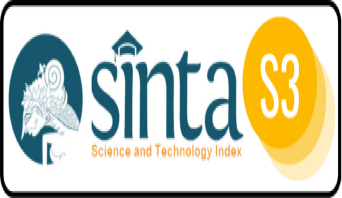EFEKTIVITAS DAUN ZODIA (Evodia suaveolens) SEBAGAI REPELLENT NYAMUK AEDES AEGYPTI
DOI:
https://doi.org/10.26630/rj.v15i1.2190Keywords:
DHF, concentration, time, repellent, zodiaAbstract
Dengue fever (DHF) is an infectious disease caused by the dengue virus through the Aedes aegypti mosquito vector. The use of repellents is an effort to prevent mosquito bites. One of the potential natural ingredients used as a repellent is zodia leaves (Evodia suaveolens) because they contain up to 46% linalool. This study aims to measure the effectiveness of the essential oil from zodia leaves as a repellent. The study was conducted on a laboratory scale following WHOPES recommendations. A total of 960 adult Ae.aegypti mosquitoes (aged 2-5 days) from the rearing process were used in this study. Five volunteers participated as probands. The essential oil is distilled from fresh azola leaves with 70% ethanol as solvent. The repellent lotion is made using an essential oil, lanolin, stearic acid, and other substance. The experiment used an arm-in-cage with two replication and 20 mosquitoes for each treatment. The concentrations tested were 1%, 2%, 3%, with 0% control. The number of mosquitoes that arrived was recorded after using the repellent for 15, 30, 60, 120, 240, and 360 minutes. The study found a significant effect of concentration (p-value <0.0001) and contact time (p-value <0.0001) on the number of mosquitoes that landed. Zodia leaf lotion (Evodia suaveolens) with a concentration of 3% can protect 50% up to 360 minutes after use. Further research is needed to get a concentration that can provide 95% protective power after 30 minutes of use and 90% after 360 minutes
References
Agustina, A., Kurniawan, B., Yusran, M., Kedokteran, F., Lampung, U., Parasitologi, B., … Lampung, U. (2019). Efektivitas Dari Tanaman Zodia ( Evodia Suaveolens ) Sebagai Insektisida Nabati Nyamuk Aedes aegypti Penyebab Demam Berdarah Effectiveness of Zodia ( Evodia Suaveolens ) Plants as Aedes aegypti Vegetable Insecticide Causes of Dengue Fever Divisio : Arthro. Medula, 9(2), 351–358.
Anindhita, Budiyono, H. (2015). Daya Tolak Repellent Bentuk Lotion Dengan Ekstrak Daun AlpukaT (Persea americana Mill) Terhadap Nyamuk Aedes aegypti Linn. 3(April).
Butarbutar, R. N., Sumampouw, O. J., & Pinontoan, O. R. (2019). Trend Kejadian Demam Berdarah Dengue Di Kota Manado Tahun 2009-2018. KESMAS - Jurnal Kesehatan Masyarakat, 8(6), 364–370.
Firdausi, A., Andrie, M., & Luliana, S. (2015). Aktivitas Repelan Minyak Atsiri Daun Jeruk Pontianak (Citrus nobilis Lour.) Terhadap Nyamuk Aedes aegypti L. Metode WHOPES. Asiswa Farmasi Fakultas Kedokteran UNTAN, 3(1), 1–9. https://doi.org/10.7788/boehlau.9783412215101.186
Fradin, M. S., & Day, J. F. (2002). Comparative efficacy of insect repellents against mosquito bites. New England Journal of Medicine, 347(1), 13–18. https://doi.org/10.1056/NEJMoa011699
Husna, Q. rahmawati, Andrie, M., & Luliana, S. (2015). Aktivitas Repelen Minyak Atsiri Kulit Buah Jeruk Pontianak (Citrus nobilis Lour.) Terhadap Nyamuk Aedes aegypti L. dengan Metode Whopes. Jurnal Mahasiswa Farmasi Fakultas Kedokteran UNTAN, 3(1), 186–269. https://doi.org/10.7788/boehlau.9783412215101.186
Kemenkes RI. (2019). Data dan Informasi profil Kesehatan Indonesia 2018. In R. Kurniawan, B. Hardhana, Yudianto, & T. Siswanti (Eds.), Data dan Informasi Profil Kesehatan Indonesia. Jakarta: Pusat Data dan Informasi Kementerrian Kesehatan Republik Indonesia.
Kukus, Y., Supit, W., & Lintong, F. (2013). Suhu Tubuh: Homeostasis Dan Efek Terhadap Kinerja Tubuh Manusia. Jurnal Biomedik (Jbm), 1(2). https://doi.org/10.35790/jbm.1.2.2009.824
Mahmudi, Santoso, H., & Laili, S. (2019). Uji Insektisida Serai (Cymbopogon nardus) dan Daun Zodia (Evodia suaveolens) Terhadap Mortalitas Nyamuk (Aedes aegypti). Jurnal Ilmiah Sains Alami, 2(1), 44–49.
Marini, & Sitorus, H. (2019). Beberapa tanaman yang berpotensi sebagai repelen di indonesia. Spirakel, 11(1), 24–33.
Mirawati, P., Simaremare, E. S., & Pratiwi, R. D. (2018). Uji Efektivitas Repellent Sediaan Lotion Kombinasi Minyak Atsiri Daun Zodia (Evodia suaveolens Scheff) dan Minyak Atsiri Batang Serai (Cymbopogon citratus) Terhadap Nyamuk Aedes aegypti L. PHARMACY: Jurnal Farmasi Indonesia (Pharmaceutical Journal of Indonesia), 15(1), 1. https://doi.org/10.30595/pharmacy.v15i1.2286
Nindatu, M., & Noya, L. (2018). Efektifitas Daya Tolak Seduhan Daun Cengkeh (Syzgium arimaticum L) Terhadap Nyamuk Anopheles Sp. Jurnal Biologi Edukasi, 53(9), 1689–1699. https://doi.org/10.1017/CBO9781107415324.004
Nur Fadilah, A. L., Cahyati, W. H., & Windraswara, R. (2017). Uji Daya Proteksi Ekstrak Daun Pepaya (Carica papaya L) Dalam Sediaan Lotion Dengan Basis PEG400 Sebagai Repellent Terhadap Aedes aegypti. Care : Jurnal Ilmiah Ilmu Kesehatan, 4(3), 318. https://doi.org/10.33366/cr.v5i3.668
Rusli, Y., & Yushananta, P. (2020). Climate variability and dengue hemorrhagic fever in Bandar Lampung, Lampung Province, Indonesia. International Journal of Innovation, Creativity and Change, 13(2), 323–336.
Sandi, I., Ariyasa, I., Teresna, I., & Ashadi, K. (2017). Pengaruh Kelembaban Relatif Terhadap Perubahan Suhu Tubuh Latihan. Sport and Fitness Journal, 5(1), 103–109.
Sanjaya, Y., Adisenjaya, Yusuf, H., & Wijayanti, L. (2014). Efektivitas Daya Tolak Ekstrak Geranium Radula Cavan terhadap Nyamuk Aedes aegypti (Linn.). Bionatura-JUrnal Ilmu-Ilmu Hayati Dan Fisik, 16(2), 62–67.
Susanti, D., & Sari, N. (2019). Inventarisasi Ragam Tumbuhan Obat Berpotensi sebagai Anti Nyamuk Inventory of Potential Medicinal Plants as Anti Mosquitoes. Jurnal Vektor Penyakit, 13(1), 7–20. https://doi.org/https://doi.org/10.22435/vektorp.v13i1.447
Utomo, P. P., & Supriyatna, N. (2014). Perbandingan daya proteksi losion anti nyamuk dari beberapa jenis minyak atsiri tanaman pengusir nyamuk. Biopropal Industri, 5(2), 79–84.
Werdiningsih, I., & Amalia, R. (2018). Lotion Ekstrak Daun Zodia (Evodia sauveolens) Sebagai Repellent Nyamuk Aedes sp. Jurnal Vektor Penyakit, 12(2), 103–108. https://doi.org/10.22435/vektorp.v12i2.839
WHO. (2009). Report of the Thirteenth Whopes Working Group Meeting. In World Health Organization (Vol. 5). Geneva.
WHOPES. (2009). Guidelines for efficacy testing of mosquito repellents for human skin. Who/Htm/Ntd/Whopes/2009.4, 1–6.
Widawati, M. (2013). the effectiveness of fixative addition on zodia (Evodia suaveolens) and rosemary (Rosmarinus officinalis) gel against Aedes aegypti. (December).
Wirastuti & Marlik. (2016). Kemampuan Efektifitas Ekstrak Daun Kenikir (Cosmos caudatus K) Dibandingkan dengan Soffell Aroma Kulit Jeruk sebagai Repellent Terhadap Nyamuk Aedes aegypti. Jurnal Penelitian Kesehatan, 7(2), 81–84.
Wirastuti, H. A., & Marlik. (2016). Kemampuan Efektifitas Ekstrak Daun Kenikir (Cosmos caudatus K) Dibandingkan dengan Soffell Aroma Kulit Jeruk Sebagai Repellent Terhadap Nyamuk Aedes aegypti. Jurnal Penelitian Kesehatan Suara Forikes, VII(2), 81–84.
Wulandari, K., & Ahyanti, M. (2018). Efektivitas Ekstrak Biji Bintaro ( Cerbera manghas ) sebagai Larvasida Hayati pada Larva Aedes aegypti Instar III. Jurnal Kesehatan Politeknik Kesehatan Tanjungkarang, 9(2010), 218–224.
Yushananta, P., & Ahyanti, M. (2014). Pengaruh Faktor Iklim Dan Kepadatan Jentik Ae.Aegypti Terhadap Kejadian DDB. Jurnal Kesehatan Lingkungan, V(1), 1–10.
Yushananta, P., Setiawan, A., & Tugiyono, T. (2020). Variasi Iklim dan Dinamika Kasus DBD di Indonesia: Systematic Review. Jurnal Kesehatan, 11(2), 294. https://doi.org/10.26630/jk.v11i2.1696
Downloads
Published
How to Cite
Issue
Section
License
Copyright (c) 2021 Ruwa Jurai: Jurnal Kesehatan Lingkungan

This work is licensed under a Creative Commons Attribution-NonCommercial 4.0 International License.

Ruwa Jurai: Jurnal Kesehatan Lingkungan is licensed under a Creative Commons Attribution-NonCommercial 4.0 International License.
Authors who publish with this journal agree to the following terms:
- Authors retain copyright and grant the journal right of first publication with the work simultaneously licensed under a Creative Commons Attribution-Non Commercial License that allows others to share the work with an acknowledgment of the work's authorship and initial publication in this journal.
- Authors are able to enter into separate, additional contractual arrangements for the non-exclusive distribution of the journal's published version of the work (e.g., post it to an institutional repository or publish it in a book), with an acknowledgment of its initial publication in this journal.
- Authors are permitted and encouraged to post their work online (e.g., in institutional repositories or on their website) prior to and during the submission process, as it can lead to productive exchanges, as well as earlier and greater citation of published work.









